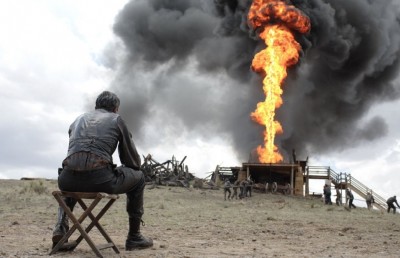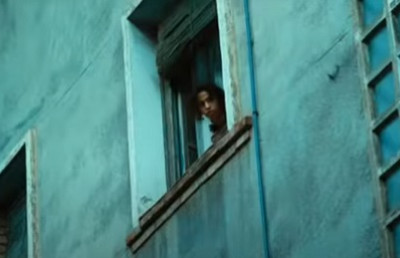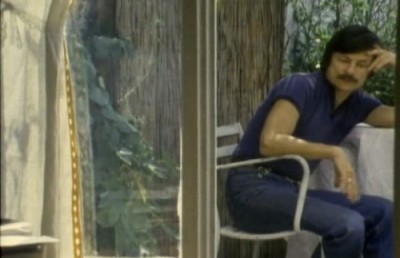Nuovo Cinema Paradiso
A Reflection of Italian Society
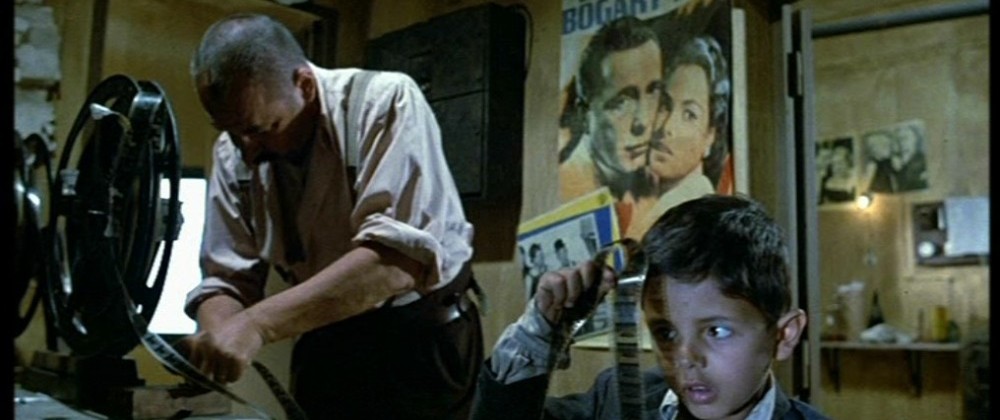
The aim of this essay is to portray how Nuovo Cinema Paradiso (1988, dir. Giuseppe Tornatore) uses the subject of cinema as a metonymy [1] for Italian society. The film’s story is about a fictional Italian filmmaker Salvatore ‘Totò’ Di Vita (Jacques Perrin) who undertakes a journey of self-discovery while visiting his Sicilian hometown, Giancaldo to attend his mentor and friend’s funeral. During the visit he remembers his two loves; a girl that he lost years ago and cinema. In this text, I will argue that Tornatore’s cinematic text is more than an exercise in simple nostalgia. Dimitris Eleftheriotis (2001, p.197) suggests that the film “signals the arrival of a new wave of Italian films with the potential to reach world-wide audiences.” [2] The point being that, at least at the peripheral levels, Nuovo Cinema Paradiso employs story-telling conventions that appeal to a non-Italian audience with little or no knowledge of Italian history. I use the term ‘periphery’ purposefully, for the film has more to it than meets the eye.
The entertainment aspect of Nuovo Cinema Paradiso can be gleaned from the film’s description by Rosalind Galt. She (2006, p.28) writes: “Cinema Paradiso tells the story of Totò, from his movie-obsessed childhood in Sicily, through a doomed first love affair, to a present-day career as a film director in Rome.” Although the film’s narration begins in medias res, Galt’s account of the plot is rational. Bearing the above exposé in mind, Tornatore crafts the film in three chapters that are childhood, adolescence and adulthood. The simple theme of each chapter, and subsequently the plain theme of the film, is love. Themes of this tangible ethos are known to film scholars as ‘perennial’. According to Mette Hjort (2000, p.106), “perennial themes bring into focus subject matter that resonates across historical and cultural boundaries.” So it can be said that the ‘love theme,’ as the denotative meaning of the film, can be seen transparently in the first viewing of the film by an international audience. The pivotal point is that Tornatore does not simply express ‘love’ in the film, but develops three versions of the concept: objective love (for films), personal heterosexual love (Totò loves Elena) and mature love (Totò returns to the place where he is conceived and re-discovers his first love, his mother’s maternal love).
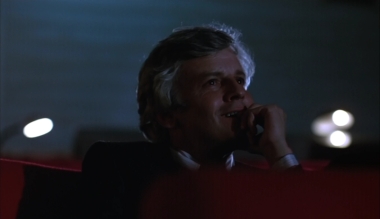
Salvatore’s love of cinema
On the other hand, there are another set of themes that are known as ‘topical themes’ that according to Hjort (2006, p.106) “involve only concepts that arise within, and remain relevant to a highly specific historical or cultural formation.” A connotative study of the film gives one the understanding that Nuovo Cinema Paradiso is an attempt by Tornatore to reconceptualise the concept of cinema, a popular medium, as a reflection of Italy’s social and political syntax following the Second World War (topical theme of the film).There are two methods of analysing Nuovo Cinema Paradiso in regards to history –considering the era that the film is made and/or the historical epoch that the film refers to. This essay focuses on both methods.
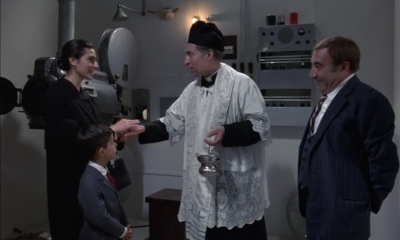
Father Adelfio (Leopold Trieste) blessing the opening of the theatre
Democrazia Cristiana (aka. DC), the Italian centrist political party, enjoyed a political monopoly [3] from 1946-1992. One of their political practices was to maintain a close association with the Catholic Church, as the Church had great influence over the people. As Pierre Sorlin notes (1996, p.5), “in the battles they [Italian regions] had to fight against centralising powers, domestic or external, the Italian cities found support in the papacy.” It can be said that seeking help from men of religion created an opportunity for the Catholic Church to gain an immense power over Italian regions. DC dominated the votes in the general election of 1946. According to Pier Paolo Pasolini, cited in Galt (2006, p.36), “[the 1946 election] ensued the continuity of power by Italian capitalists working together with the Catholic Church.” It was throughout the 1980s that what I call ‘new political consciousness’ formed among the masses of Italy and participated to end the DC’s political stranglehold on Italy. According to Galt (2006), the climax of events of the 1990s occurred in 1992 when the judicial operation of Mani Pulite (operation clean hands) began, and which led to the downfall of the DC.
It can be seen from the above account of Italy’s modern history that Nuovo Cinema Paradiso, born towards the end of a political era in Italy, was a reflection of the country’s status quo in the first years of the DC’s government. However, the film does not deal with politics directly (in contrast with Il Postino), but attacks and criticises the Church for interfering with cinema and popular culture. In a literary construal of history, the Church is like the Ministry of Truth from George Orwell’s ‘Nineteen Eighty-Four’ (1949). Therefore the Church, as an aide of the state, controls art and culture, thusly metamorphosing the hegemony of the country.
One of the Church’s policies for performing its domineering character was establishing parish cinemas, especially in smaller towns and villages. Through these cinemas the Church was able to show films while censoring them to fit with its version of morality and political righteousness. This meant not showing films considered to be leftist or communist in addition to eliminating love scenes from the films that they would release. Stephen Gundale, cited in Baranski and Lumley (1990), says that during the 1950s (when the events of Cinema Paradiso occur) 5,500 parish cinemas were operating. Furthermore, he (1990, p.200) writes: “by the mid fifties Italians were going to the cinema 24 times per year on average, more frequently than any other continental European nation.” So it can be surmised that the vertex of cinema-going as a social stimulus in Italy coincides with the Church exerting its power over this visual medium.
Nuovo Cinema Paradiso initially focuses on a small parish cinema in Giancaldo, a province in Sicily. Gundale (1990, p.201) depicts such a place as follows: “out of town cinemas were rough and ready places, hastily converted buildings in which a throng of people would sit uncomfortably on hard wooden seats to watch a worn out print of an old film.” These descriptions are valid in the case of the parish cinema in the film. Furthermore, Father Adelfio (Leopold Trieste), the most legitimate person to be called the antagonist of the film, is in charge of censoring the films that are released in the cinema. Gundale criticises this practice of the Church by writing: “because the Catholics had no clear perception of what sort of cinemas they really wanted, their interference was often merely narrow minded and petty.” Narrow-minded indeed; the film’s audiences witness how Adelfio constantly keeps ringing his ‘censor bell’ (so the projectionist knows which part of the film should be cut). [4]
Tornatore tackles the two sides of Christianity in the first ten minutes of the film; a maternal side and a dogmatic one. Adelfio, prior to his entering the cinema, is depicted in his room changing clothes. There is a moment that the left door of his wardrobe is open and the camera zooms in on a statue of Madonna in the closet. This depiction is what I call ‘the maternal religion’. It is the positive icon of religion, for first of all the statue is situated on the left side, which is in contrast with the Catholic Church’s affiliation with the political right party (so the statue is not on the ‘right’ side of the wardrobe). Moreover, Madonna represents the mother figure, and love. Thus by being hidden in the closet, it encodes the message that the Church hides love, which explains why they cut love scenes from the films. On the contrary, Adelfio is an agent of dogmatic Christianity who handles the bell. In the climax of censoring the films, Tornatore dexterously cuts the scene to the big ringing bell of the church. [5] The bell’s evolution in the film portrays how a small controlling bell inside the cinema becomes a full-size one, located in the centre of the society that it controls; an expression of how cinema is used as a metonymy for Italian society.
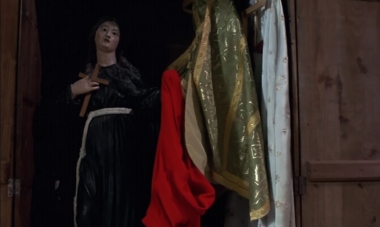
An interpretation of a polysemic text such as film can shape the mind of scholars to antithetical readings. However, it should be mentioned that in most literature on the film scholars are obsessed with the existence of ‘nostalgia’ in Nuovo Cinema Paradiso. For these scholars, the film epitomises two kinds of nostalgia; the first type (which I name ‘sentimental nostalgia’) suggests that the film is “a part of canon that shows good old days of cinema.” (Sorlin, 1996, p.160) The second notion develops a ‘political nostalgia’; that is, Nuovo Cinema Paradiso is a cinematic attempt to explain why the DC, alongside the Church, manipulated the Italian people for so long.
I would like to propose a counter argument to this reading of the film through the theme of nostalgia. Initially, it should be clarified that at no point in the film does Tornatore say how or why things went wrong politically after WWII (and how could he when, in 1988, the DC was still power?) On the contrary, solely by showing what happened, he privileges his audience with the opportunity to develop their own individual understanding of the film. As Sorlin (1996, p.161) puts it, “the cinema of the 1980s was serious and moralising. It did not offer solutions, but it attempted to make spectators look at the shortcomings of the period.”
In addition to the above argument it should be said that ‘sentimental nostalgia’ provides us with the idea that the golden years of cinema are long gone. It is intriguing how film scholars are obsessed with the medium (cinema) and not the encoded messages in the films. The contravening idea that this essay suggests is that cinema per se is merely a tool, an architectural phenomenon for showing films. So if we can reach the films through other mediums, why not do so? [6] Eleftheriotis (2001, p.201), one of the scholars who champions a nostalgic reading of the film, describes Alberto’s (Philippe Noiret) blindness as follows: “Alberto’s misfortune can be read as a punishment for his inability to control and contain the film-experience within the walls of the theatre, within the fixed position of the apparatus.” There are two issues with this idea that should be recontextualised:
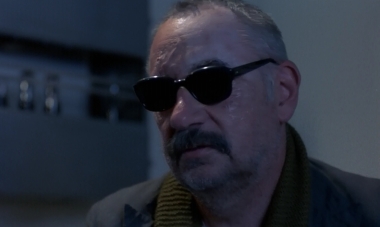
The blind Alberto (Philippe Noiret)
1. The ‘misfortune’ that Eleftheriotis speaks of exists only on the peripheral level reading of the scene, i.e. although Alberto is blinded by the burning projector, through the course of the narration he nevertheless manages to reclaim his equilibrium. By this, I refer to his everlasting friendship with Totò and how he persuades Totò to leave Giancaldo, consequently becoming a successful film director. Furthermore, Alberto admits himself that now that “he is blind, he can see better.” So, it can be concluded that blindness is part of Alberto’s personal evolution towards wisdom.
2. The so-called “punishment” suggests that Alberto failed to control the “film-experience.” This reading is in contrast to the encoded message of the film in the burning scene, which implies that the experience of viewing films must be liberated and reach any individual who wants to observe films, even if this requires the sacrifice of an individual (Alberto).
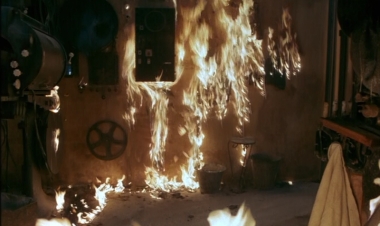
I would like to conclude by observing that writers such as Galt or Eleftheriotis constantly refer to the film as ‘Cinema Paradiso??’ instead of ??Nuovo Cinema Paradiso. The cinema in the film, while still called Cinema Paradiso, represents a restricted parish cinema, where the upper-class official, who is located in a premiere balcony seat, spits on the ordinary people who sit in the standard seats. However, after renovation of the cinema, when it is called Nuovo Cinema Paradiso (and is no more a parish cinema, but owned by a private business), the official receives a used, very soiled nappy from the lower level of the cinema as a sign of protest as well as recognition (we know it was you all along who spat at us). The significance of this metamorphosis is emphasised through intertextuality; this scene is juxtaposed with a scene from Federico Fellini’s I vitelloni (1953), which stars a young Leopold Trieste, who plays Father Adelfio in Nuovo Cinema Paradiso. In the scene in question a group of young, largely unemployed men insult a group of road workers from their car. However, when their car breaks down a little further down the road and the workers start to chase them the main offender, played by Alberto Sordi, cowardly feigns that he is a ‘communist’ to escape punishment. The praxis of this scene in Nuovo Cinema Paradiso manifests how Alberto’s sacrifice emancipates people’s consciousnesses and assists them to protest the exploitation of the official in the upper seat. This protest also refers to Italy’s society of the 1980s, when people started to oppose the DC government.
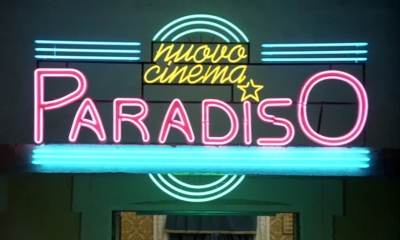
Endnotes
1 According to Fiske (1982) ‘metonymy’ is when, in a chosen text, a part of the concept stands for the whole. Thus in ??Nuovo Cinema Paradiso??, the cinema in Giancaldo stands for the entire Italian society.
2 His opinion proved to be legitimate, considering films like Mediterraneo (1991, dir. Gabriele Salvatores), Il postino (1994, dir. Michael Radford) and La vita è bella (1997, dir. Roberto Benigni).
3 To be more accurate, the DC swayed between centre-left and centre-right depending on the political climate. In this period the only single time that the DC lost power was between 4th August 1983 and 17th April 1987 to Bettino Craxi (1934-2000) from Italian Partito Socialista Italiano.
4 All the scenes to which the Catholic priest objects involve the films’ characters kissing each other. And after all, what is a kiss except the pressure of lips? Furthermore, Totò witnesses how the priest cut the love scenes, and perhaps this is why his love affairs are short-term and doomed.
5 I compare this significant evolution to the dynamic shift in Stanley Kubrick’s 2001: A Space Odyssey (1968) where a piece of bone in the hand of a sub-human developed into a spaceship.
6 The only way for film to survive as both an entertainment and intellectual concept in most of Asia, where governments do not allow films to be released freely and in full-version in the cinema, is for ardent viewers to see the films on video or DVD.
Bibliography
Branski, Zygmunt. And Lumley, Robert (1990) Culture and Conflict in Post War Italy, London: The Macmillan Press Ltd.
Eleftheriotis, Dimitris. (2001) Popular Cinemas of Europe: Studies of Texts, Contexts and Frameworks, New York: The Continuum International Publishing Group INC.
Fiske, John. (1982) Introduction to communication, London: Methuen Publishers.
Galt, Rosalind. (2006) The New European Cinema: Redrawing the Map, New York: Columbia University Press.
Hjort, Mette. And Mackenzie, Scott (2000) Cinema and Nation, London: Routledge.
Orwell, George (1949) Nineteen eighty-four, London: Martin Secker and Warburg Limited.
Sorlin, Pierre. (1996) Italian National Cinema: 1896-1996, London: Routledge.


